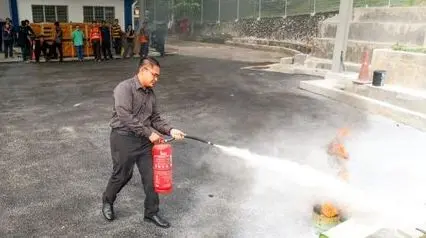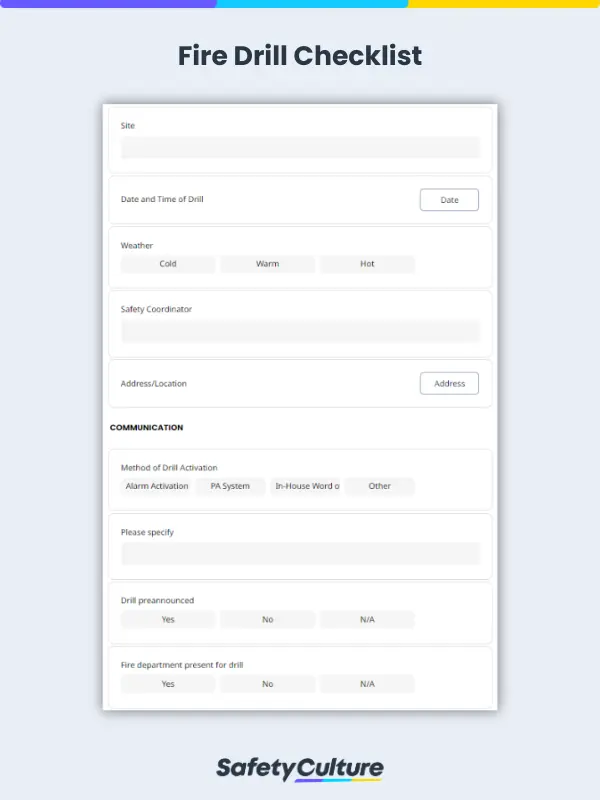What is a Fire Drill Checklist?
A fire drill checklist is used by safety coordinators to ensure that emergency evacuation procedures are established and prepared before the scheduled drill. It helps streamline emergency procedures and business contingency plans, while also evaluating equipment readiness.
Are Fire Evacuation Drills a Legal Requirement?
Fire evacuation drills are conducted in the UK in compliance with The Regulatory Reform (Fire Safety) Order 2005. Regular drills help refresh individual knowledge on safety evacuation to avoid unnecessary incidents or fatality caused by fire.
3 Reasons Your Establishment Needs a Fire Drill Log
While some might find fire drills and its associated documentation tedious and time-consuming, it is a necessary step in preparing for one of the worst-case scenarios workers and students can face. 2018 alone recorded the following statistics for commercial building fires reported by FEMA:
- 379,600 reported fires
- 2,790 deaths
- 11,525 injuries
- $8,194,500,000 in dollar loss
Considering the substantial damage caused by commercial building fires to lives and property, below are some of the reasons your establishment needs a fire drill log:
It prepares personnel for swift action and helps improve fire emergency protocols
Scheduling regular fire drills help ensure that workers, students, and other people who regularly occupy buildings know what needs to be done in case of a fire emergency. Fire drill logs, on the other hand, help safety officers document what went well, and what needs improvement regarding the fire emergency SOPs.
It helps ensure that all personnel are safely evacuated
One of the most important sections of a fire drill log is the documentation of total occupants evacuated. This helps ensure that no occupant is left behind and that everyone is accounted for upon evacuation. It also takes building guests into account and any persons with disabilities that may require special assistance when evacuating the building.
It helps ensure that the right data is gathered from fire drills
Fire drill logs or checklists also serve as guides to ensure that safety officers don’t miss essential fire drill data that can help inform protocols for real-life emergencies. Was the fire drill pre-announced or not? Were evacuation signs legible and in good condition? Were exits clearly marked and properly illuminated? Were fire alarms working properly and loud enough to be heard across the building? These are some of the small details that can determine the success or failure of a real-life fire evacuation.
Top 3 Tips for Creating an Effective Fire Drill
Preparation is key in overcoming crisis situations. With serious injuries and fatalities being common in building fires, personnel must have the knowledge and ability to follow safety protocols in order to evacuate safely, and efficiently. Prior to your fire drill’s implementation, however, your organization must do their due diligence to ensure that it is effective. Below are some valuable tips for creating an effective fire drill:
Consult A Local Fire Emergency Expert
Before drawing up the official fire drill procedure, safety officers should get in touch with a local fire marshal for a walkthrough inspection of the building. By doing so, the fire marshal can provide recommendations and expert advice; greatly improving the quality and effectiveness of the fire drill.
Establish a Fire Emergency Point Person for Each Department
A safety officer will find it difficult to keep track of all evacuees during fire drills and in real-life emergencies. For this reason, a point person for each department must be established. The point person’s job is to ensure that each person from their department evacuates safely. While everyone is expected to know the proper exit points and protocols, point persons have the added responsibility of enforcing them; a critical role in emergency situations.
Ensure the Emergency Protocol’s Flexibility by Introducing Different Scenarios
Due to the unpredictable nature of emergencies, protocols serve as guidelines rather than step-by-step instruction manuals. In order to ensure that your fire drill is effective in practicing personnel for real-life emergencies, introduce different scenarios to assess the relevance of your current fire emergency protocols.
5 Essential Steps to Do Before and After a Fire Evacuation Drill
Fire evacuation drill is often neglected by many. Inadequate implementation of fire evacuation drills can result to panic, chaos, and miscommunication. Due to lack of proper fire drill execution, people do not have sufficient knowledge about the point of evacuation, the safety equipment available, and how to properly use them in the event of fire.
Therefore, all businesses should perform fire evacuation drills as part of their emergency procedure to protect people from major injuries. Here are 5 essential steps to help safety officers and coordinators to perform fire evacuation drill more efficiently:
-
Coordinate with all relevant parties
Fire evacuation drills should be scheduled, planned, and calibrated by all relevant parties including the fire department, building/ property owners, and tenants. A notification should be sent with specific details to clarify what to do during the drill.
-
Establish fire emergency procedures
Gather employees and coordinate what to expect during the drill. Divide the group into small teams and assign a trained fire warden to observe and help employees if unexpected issues occur. Organize and facilitate the entire evacuation procedure. Clearly state the emergency evacuation plan, discuss the do’s and don’ts during the drill, and point out the evacuation area.
-
Secure your team
Make a list of all attending participants and ensure everybody knows the point of registry. Communicate if there are people with disabilities (PWD) and visitors that need special attention. Make sure these people know the building protocols and safety procedures.
-
Assess the fire evacuation process
Evaluate the whole process of fire evacuation and identify areas for improvement. Assign immediate actions for any noncompliance observed and create a report to comply with legal requirements.
-
Use technology to help ensure fire evacuation safety
A paper-based fire evacuation drill checklist can be easily damaged and misplaced during the drill. The inconvenience of using pen and paper to record your visual inspections and observations would be challenging and time-consuming. By using a powerful inspection app like SafetyCulture (formerly iAuditor), you can:
-
- Perform pre-drill inspections with a mobile device.
- Attach or capture photos of potential hazards with detailed descriptions.
- Keep your inspection and assessment records secure in the cloud.
- Share fire drill reports faster and more efficiently.



